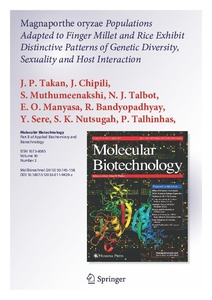| dc.contributor.author | Takan, J.P. |
| dc.contributor.author | Chipili, J. |
| dc.contributor.author | Muthumeenakshi, S. |
| dc.contributor.author | Talbot, N.J. |
| dc.contributor.author | Manyasa, E.O. |
| dc.contributor.author | Bandyopadhyay, Ranajit |
| dc.contributor.author | Sere, Y. |
| dc.contributor.author | Nutsugah, S.K. |
| dc.contributor.author | Talhinhas, P. |
| dc.contributor.author | Hossain, M.A. |
| dc.contributor.author | Brown, A. |
| dc.contributor.author | Sreenivasaprasad, S. |
| dc.date.accessioned | 2019-12-04T11:07:43Z |
| dc.date.available | 2019-12-04T11:07:43Z |
| dc.date.issued | 2012 |
| dc.identifier.citation | Takan, J.P., Chipili, J., Muthumeenakshi, S., Talbot, N. J., Manyasa, E.O., Bandyopadhyay, R., ... & Sreenivasaprasad, S. (2012). Magnaporthe oryzae populations adapted to finger millet and rice exhibit distinctive patterns of genetic diversity, sexuality and host interaction. Molecular Biotechnology, 50(2), 145-158. |
| dc.identifier.issn | 1073-6085 |
| dc.identifier.uri | https://hdl.handle.net/20.500.12478/1548 |
| dc.description.abstract | In this study, host-specific forms of the blast pathogen Magnaporthe oryzae in sub-Saharan Africa (SSA) were characterised from distinct cropping locations using a combination of molecular and biological assays. Finger millet blast populations in East Africa revealed a continuous genetic variation pattern and lack of clonal lineages, with a wide range of haplotypes. M. oryzae populations lacked the grasshopper (grh) element (96%) and appeared distinct to those in Asia. An overall near equal distribution (47–53%) of the mating types MAT1-1 and MAT1-2, high fertility status (84–89%) and the dominance of hermaphrodites (64%) suggest a strong sexual reproductive potential. Differences in pathogen aggressiveness and lack of cultivar incompatibility suggest the importance of quantitative resistance. Rice blast populations in West Africa showed a typical lineage-based structure. Among the nine lineages identified, three comprised ~90% of the isolates. Skewed distribution of the mating types MAT1-1 (29%) and MAT1-2 (71%) was accompanied by low fertility. Clear differences in cultivar compatibility within and between lineages suggest R gene-mediated interactions. Distinctive patterns of genetic diversity, sexual reproductive potential and pathogenicity suggest adaptive divergence of host-specific forms of M. oryzae populations linked to crop domestication and agricultural intensification. |
| dc.description.sponsorship | Department for International Development, United Kingdom |
| dc.language.iso | en |
| dc.subject | Finger Millet |
| dc.subject | Rice |
| dc.subject | Blast Disease |
| dc.subject | Magnaporthe Oryzae |
| dc.subject | Pathogen Populations |
| dc.subject | Genetic Variation |
| dc.subject | Mating Type Distribution |
| dc.subject | Fertility Status |
| dc.subject | Pathogenicity |
| dc.subject | Adaptive Divergence |
| dc.title | Magnaporthe oryzae populations adapted to finger millet and rice exhibit distinctive patterns of genetic diversity, sexuality and host interaction |
| dc.type | Journal Article |
| dc.description.version | Peer Review |
| cg.contributor.crp | Rice |
| cg.contributor.crp | Agriculture for Nutrition and Health |
| cg.contributor.affiliation | University of Warwick |
| cg.contributor.affiliation | NaSARRI, Uganda |
| cg.contributor.affiliation | Ministry of Agriculture, Zambia |
| cg.contributor.affiliation | University of Exeter |
| cg.contributor.affiliation | International Crops Research Institute for the Semi-Arid Tropics |
| cg.contributor.affiliation | International Institute of Tropical Agriculture |
| cg.contributor.affiliation | Africa Rice Center |
| cg.contributor.affiliation | Queen's University Belfast |
| cg.contributor.affiliation | University of Bedfordshire |
| cg.coverage.region | Africa |
| cg.coverage.region | West Africa |
| cg.coverage.region | East Africa |
| cg.coverage.country | Ghana |
| cg.coverage.country | Nigeria |
| cg.coverage.country | Kenya |
| cg.coverage.country | Uganda |
| cg.isijournal | ISI Journal |
| cg.authorship.types | CGIAR and developing country institute |
| cg.iitasubject | Genetic Improvement |
| cg.iitasubject | Food Security |
| cg.journal | Molecular Biotechnology |
| cg.howpublished | Formally Published |
| cg.accessibilitystatus | Limited Access |
| local.dspaceid | 82109 |
| cg.identifier.doi | https://dx.doi.org/10.1007/s12033-011-9429-z |

